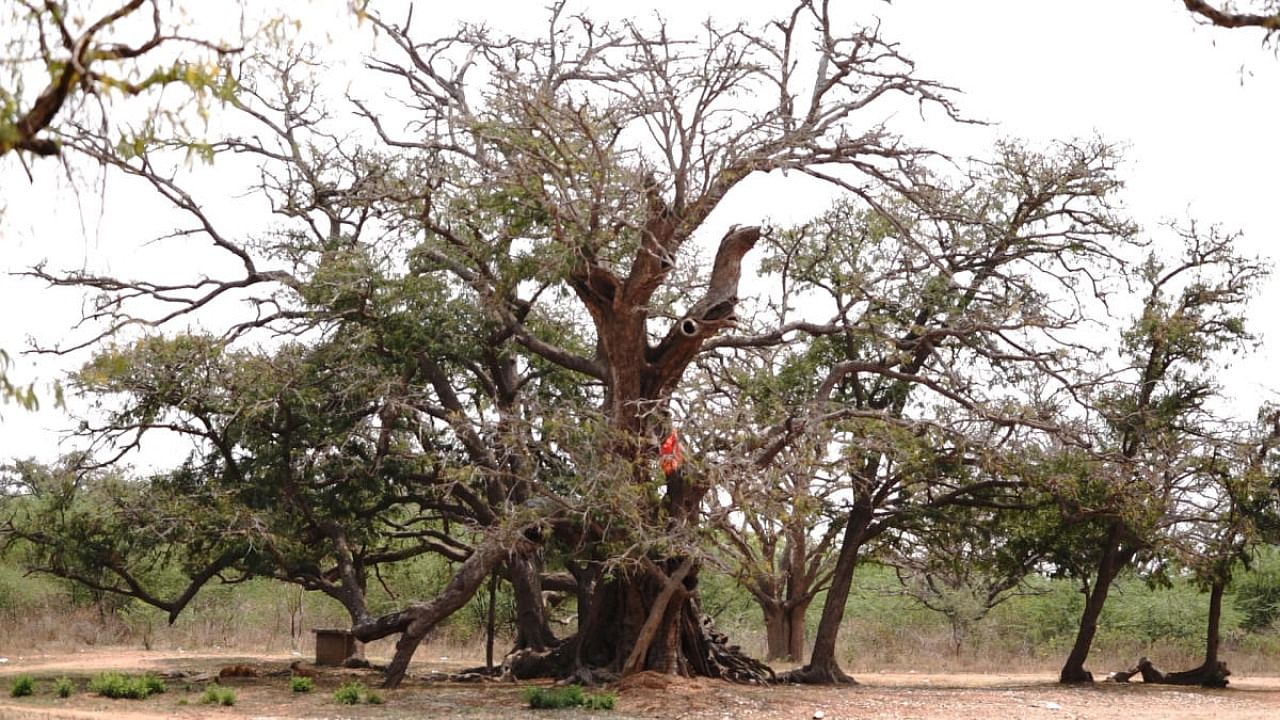

The tamarind trees in Nallur have stood tall for four centuries. With 292 tamarind trees, according to carbon dating estimates, some of the oldest trees in the grove are more than 400 years old.
Located in Nallur village of Devanahalli Taluk, near Bengaluru International Airport, the grove was the first in the country to be declared a ‘Biodiversity Heritage Site’ by the National Biodiversity Authority in 2007. Fifteen years after this recognition, the plight of the 54-acre area paints a sorry picture.
The trees make for an interesting study as the commercial lifespan of a tamarind tree is only 200 years. Situated just 46 km from Bengaluru, the area is home to more than 60 species of flora and fauna including pangolin, slender loris, sunbird, russell’s viper, cobra, banyan, wood apple and several other varieties of trees.
There is also a dilapidated Channakeshava temple which is said to have been built during the 12th-century king Rajendra Chola’s reign. Residents in the area believe that around the groves and temple, once stood a fort that was destroyed due to conflicts. Yet, the place still retains the name ‘Nalluru Kote (Nalluru fort)’.
With aerial roots and tree suckers that grow as separate trees, the tamarind trees here have unique features. “A tree was struck by lightning 200 years ago. One of the pieces grew towards the right and the other to the left, leaving a walkable path in between. This is very rare,” said Santhe Narayana Swamy, former senior director of horticulture.
A gram panchayat auction of the yield of tamarind every January would fetch Rs 1.5 lakh on average to the government. The auction has not taken place this year as most of the yield was stolen from the hardly protected grove. According to Karnataka Biodiversity Board’s (KBB) latest report available in the public domain, Rs 1 lakh was allocated for the maintenance of the four biodiversity heritage sites in Karnataka. However, not a single penny has been spent.
In danger
This centuries-old grove is in a state of neglect. The fencing around the area was built in 2009 and was removed over the years by local shepherds for cattle grazing. Though the grove doesn’t attract many tourists, some tipplers litter the place with bottles and plastic. The vast area has a lone security guard who is not paid regularly despite being on the job for 12 years. Conservation efforts have been minimal.
The heritage site now faces fresh threat as the state government plans to go ahead with phase-2 of Haraluru Industrial Area of Devanahalli taluk whose jurisdiction lies near the grove. It is currently in the final notification period.
“A lot of fertile agricultural land near the grove has already been acquired by authorities without proper evaluation of the nature of industries and environmental threats. Pollution from different industries will cause serious harm to the biodiversity of tamarind grove and also affect the livelihood of locals,” said R Anjaneya Reddy, an environmental activist.
According to Reddy, the systemic neglect of the grove is deliberate. “If the biodiversity of the place is expunged, it will be easy for authorities to convert the land for other purposes,” Reddy said.
In March 2020, the Karnataka Biodiversity Board conducted a meeting with the concerned Biodiversity Management Committee to discuss the conservation of the biodiversity heritage site. “Later, the KBB obtained a proposal from Karnataka Forest Department (KFD) for a funding of Rs 5 lakh to take up management activities through KFD. After obtaining approval in a board meeting in February, the release of funds is under process,” said Anitha S Arekal, member secretary of Karnataka Biodiversity Board, adding that KFD’s fund requirement is nearly 80 lakhs, but KBB could only give a token amount.
If industries were to set up base here, the greenery in the surroundings would vanish believes S V Hittalmani, Retired Additional Director of Horticulture.
“The area could become a ‘green oasis’, making it vulnerable to human and animal pressure. The groundwater level would further deplete, dealing a death blow to the old trees of the grove,” said Hittalmani. The grove’s conservation would need a minimum funding of Rs 2 crore, he added.
“Local farmers have been raising objections against industrial area extension. The government will go ahead with the project making sure that there would be no harm to locals and the environment,” said a government source.
(With inputs from Adithyan P C)